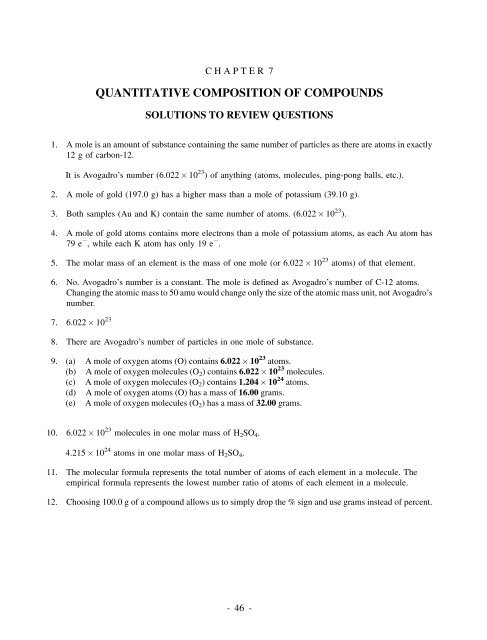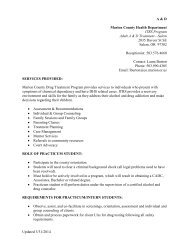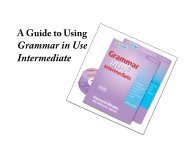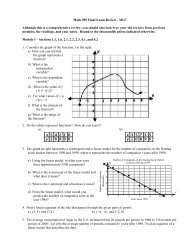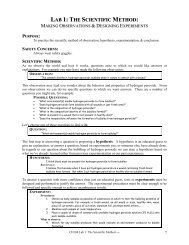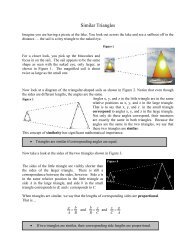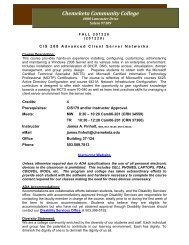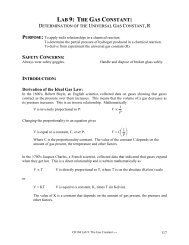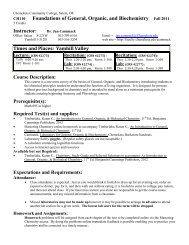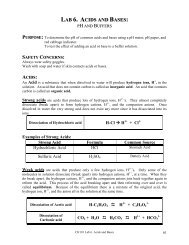Chapter 7
Chapter 7
Chapter 7
You also want an ePaper? Increase the reach of your titles
YUMPU automatically turns print PDFs into web optimized ePapers that Google loves.
CHAPTER 7QUANTITATIVE COMPOSITION OF COMPOUNDSSOLUTIONS TO REVIEW QUESTIONS1. A mole is an amount of substance containing the same number of particles as there are atoms in exactly12 g of carbon-12.It is Avogadro’s number (6.022 10 23 ) of anything (atoms, molecules, ping-pong balls, etc.).2. A mole of gold (197.0 g) has a higher mass than a mole of potassium (39.10 g).3. Both samples (Au and K) contain the same number of atoms. (6.022 10 23 ).4. A mole of gold atoms contains more electrons than a mole of potassium atoms, as each Au atom has79 e , while each K atom has only 19 e .5. The molar mass of an element is the mass of one mole (or 6.022 10 23 atoms) of that element.6. No. Avogadro’s number is a constant. The mole is defined as Avogadro’s number of C-12 atoms.Changing the atomic mass to 50 amu would change only the size of the atomic mass unit, not Avogadro’snumber.7. 6.022 10 238. There are Avogadro’s number of particles in one mole of substance.9. (a) A mole of oxygen atoms (O) contains 6.022 10 23 atoms.(b) A mole of oxygen molecules (O 2 ) contains 6.022 10 23 molecules.(c) A mole of oxygen molecules (O 2 ) contains 1.204 10 24 atoms.(d) A mole of oxygen atoms (O) has a mass of 16.00 grams.(e) A mole of oxygen molecules (O 2 ) has a mass of 32.00 grams.10. 6.022 10 23 molecules in one molar mass of H 2 SO 4 .4.215 10 24 atoms in one molar mass of H 2 SO 4 .11. The molecular formula represents the total number of atoms of each element in a molecule. Theempirical formula represents the lowest number ratio of atoms of each element in a molecule.12. Choosing 100.0 g of a compound allows us to simply drop the % sign and use grams instead of percent.-46-
- <strong>Chapter</strong> 7 -SOLUTIONS TO EXERCISES1. Molar masses(a) KBr 1 K 39.10 g1 Br 79.90 g119.0(b) Na 2 SO 4 2 Na 45.98 g1 S 32.07 g4 O 64.00 g142.1 g(c) Pb(NO 3 ) 2 1 Pb 207.2 g2 N 28.02 g6 O 96.00 g331.2 g(d) C 2 H 5 OH 2 C 24.02 g6 H 6.048 g1 O 16.00 g46.07 g(e) HC 2 H 3 O 2 4 H 4.032 g2 C 24.02 g2 O 32.00 g60.05 g(f) Fe 3 O 4 3 Fe 167.6 g4 O 64.00 g231.6 g(g) C 12 H 22 O 11 12 C 144.1 g22 H 22.18 g11 O 176.0 g342.3 g(h) Al 2 (SO 4 ) 3 2 Al 53.96 g3 S 96.21 g12 O 192.0 g342.2 g(i) (NH 4 ) 2 HPO 4 9 H 9.072 g2 N 28.02 g1 P 30.97 g4 O 64.00 g132.1 g-47-
- <strong>Chapter</strong> 7 -2. Molar masses(a) NaOH 1 Na 22.99 g1 O 16.00 g1 H 1.008 g40.00 g(b) Ag 2 CO 3 2 Ag 215.8 g1 C 12.01 g3 O 48.00 g275.8 g(c) Cr 2 O 3 2 Cr104.0 g3 O 48.00 g152.0 g(d) (NH 4 ) 2 CO 3 2 N 28.02 g8 H 8.064 g1 C 12.01 g3 O 48.00 g96.09 g(e) Mg(HCO 3 ) 2 1 Mg 24.31 g2 H 2.016 g2 C 24.02 g6 O 96.00 g146.3 g(g) C 6 H 5 COOH 7 C 84.07 g6 H 6.048 g2 O 32.00 g122.1 g(g) C 6 H 12 O 6 6 C 72.06 g12 H 12.10 g6 O 96.00 g180.2 g(h) K 4 Fe(CN) 6 4 K 156.4 g1 Fe 55.85 g6 C 72.06 g6 N 84.06 g368.4 g(i) BaCl 2 2H 2 O 1 Ba 137.3 g2 Cl 70.90 g4 H 4.032 g2 O 32.00 g244.2 g-48-
- <strong>Chapter</strong> 7 -6. Number of grams.(a) 4:25 10 4 98:09 g H 2 SO 4mol H 2 SO 4 ¼ 0:0417 g H 2 SO 4mol H 2 SO 4(b) 4:5 10 22 1 mol153:8 g CCl4molecules CCl 46:022 10 23 ¼ 11 g CCl 4molecules mol CCl 4 47:87 g Ti(c) ð0:00255 mol TiÞ ¼ 0:122 g Timol Ti(d) 1:5 10 16 atoms S 32:07 g S6:022 10 23 ¼ 8:0 10 7 gSatoms S7. Number of molecules(a) ð2:5 mol S 8 Þ 6:022 1023 molecules¼ 1:5 10 24 molecules S 8mol(b)ð7:35 mol NH 3 Þ 6:022 1023 molecules¼ 4:43 10 24 molecules NH 3mol(c)ð17:5gC 2 H 5 OHÞ 1023 molecules¼ 2:29 10 23 molecules C 2 H 5 OH46:07 g C 2 H 5 OH(d)ð255 g Cl 2 Þ 6:022 1023 molecules¼ 1:91 10 24 molecules Cl 270:90 g Cl 28. Number of molecules(a) ð9:6 mol C 2 H 4 Þ 6:022 1023 molecules¼ 5:8 10 24 molecules C 2 H 4mol(b)ð2:76 mol N 2 OÞ 1023 molecules¼ 1:66 10 24 molecules N 2 Omol(c)ð23:2gCH 3 OHÞ 1023 molecules¼ 4:36 10 23 molecules CH 3 OH32:04 g CH 3 OH(d)ð32:7 g CCl 4 Þ 6:022 1023 molecules¼ 1:28 10 23 molecules CCl 4153:8 g CCl 49. Number of atoms 7 atoms(a) ð25 molecules P 2 O 5 Þ1 molecules(b) ð3:62 mol O 2 Þ 6:022 1023 moleculesmol¼ 1:8 10 2 atoms 2 atoms¼ 4:36 10 24 atoms1 molecule 3 atoms¼ 2:20 10 25 atoms1 molecule(c) ð12:2 mol CS 2 Þ 6:022 1023 moleculesmol-50-
- <strong>Chapter</strong> 7 -(d)ð1:25 g NaÞ 1023 atoms¼ 3:27 10 22 atoms22:99 g Na(e)ð2:7gCO 2 Þ 6:022 1023 molecules 3 atoms¼ 1:1 10 23 atoms44:01 g CO 2 1 molecule(f)ð0:25 g CH 4 Þ 6:022 1023 molecules 5 atoms¼ 4:7 10 22 atoms16:04 g CH 4 1 molecule10. (a) 8 atomsð2 molecules CH 3 COOHÞ¼ 16 atoms1 molecule(b)ð0:75 mol C 2 H 6 Þ 6:022 1023 molecules 8 atoms¼ 3:6 10 24 atomsmol1 molecule(c)ð25 mol H 2 OÞ 1023 molecules 3 atoms¼ 4:5 10 25 atomsmol1 molecule(d)ð92:5gAuÞ 6:022 1023 atoms¼ 2:83 10 23 atoms197:0gAu(e)ð75 g PCl 3 Þ 6:022 1023 molecules 4 atoms¼ 1:3 10 24 atoms137:3 g PCl 3 1 molecule(f)ð15 g C 6 H 12 O 6 Þ 6:022 1023 molecules 24 atoms¼ 1:2 10 24 atoms180:2gC 6 H 12 O 6 1 molecule11. Number of grams.4:003 g(a) ð1 atom HeÞ6:022 10 23 ¼ 6:647 10 24 gHeatoms12:01 g(b) ð15 atoms CÞ6:022 10 23 ¼ 2:991 10 22 gCatoms108:0gN 2 O 5(c) ð4 molecules N 2 O 5 Þ6:022 10 23 ¼ 7:175 10 22 gN 2 O 5molecules93:13 g C 6 H 5 NH 2(d) ð11 molecules C 6 H 5 NH 2 Þ6:022 10 23 ¼ 1:701 10 21 gC 6 H 5 NH 2molecules131:3gXe12. (a) ð1 atom XeÞ6:022 10 23 ¼ 2:180 10 22 gXeatoms35:45 g Cl(b) ð22 atoms ClÞ6:022 10 23 ¼ 1:295 10 21 gClatoms-51-
- <strong>Chapter</strong> 7 -60:05 g CH 3 COOH(c) ð9 molecules CH 3 COOH6:022 10 23 ¼ 8:975 10 22 gCH 3 COOHmolecules 116:1gC 4 H 4 O 2 ðNH 2 Þ(d) 15 molecules C 4 H 4 O 2 ðNH 2 Þ 226:022 10 23 ¼ 2:892 10 21 gC 4 H 4 O 2 ðNH 2 Þmolecules213. (a)ð25 kg CO 2 Þ 1000 g 1 mol CO2¼ 5:7 10 2 mol CO 2kg 44:01 g CO 2(b)1 mol Pbð5 atoms PbÞ6:022 10 23 ¼ 8 10 24 mol Pbatoms(c)ð6 mol O 2 Þ 6:022 1023 molecules O 2 2 atoms¼ 7 10 24 atomsmol O 21 molecule O 2(d)123:9gP 4ð25 molecules P 4 Þ6:022 10 23 ¼ 5:1 10 21 gP 4molecules P 41 mol W14. (a) ð275 atoms WÞ6:022 10 23 ¼ 4:57 10 22 mol Watoms(b) ð95 mol H 2 OÞ 2O 1kg¼ 1:7kgH 2 Omol H 2 O 1000 g(c)64:07 g SO 2ð12 molecules SO 2 Þ6:022 10 23 ¼ 1:3 10 21 gSO 2molecules SO 2(d)ð25 mol Cl 2 Þ 6:022 1023 molecules Cl 2 2 atoms¼ 3:0 10 25 atomsmol Cl 21 molecule15. One molecule of tetraphosphorusdecoxide (P 4 O 10) contains:1 mol P 4 O 10(a) ð1 molecule P 4 O 10 Þ6:022 10 23 ¼ 1:661 10 24 mol P 4 O 10molecules(b) 1:661 10 24 283:9gP 4 O 10mol P 4 O 10 ¼ 4:714 10 22 gP 4 O 10mol(c)4 P atomsð1 molecule P 4 O 10 Þ¼ 4 atoms P1 molecule P 4 O 10(d)10 O atomsð1 molecule P 4 O 10 Þ¼ 10 atoms O1 molecule P 4 O 10(e)14 atomsð1 molecule P 4 O 10 Þ¼ 14 total atoms1 molecule P 4 O 10-52-
- <strong>Chapter</strong> 7 -16. 125 grams of disulfur decofluoride (S 2 F 10 ) contains:(a)1 mol S 2 F 10ð125 g S 2 F 10 Þ¼ 0:492 mol S 2 F 10254:1gS 2 F 10(b)ð0:492 mol S 2 F 10 Þ 6:022 1023 molecules¼ 2:96 10 23 molecules S 2 F 10mol S 2 F 10(c)ð0:492 mol S 2 F 10 Þ 6:022 1023 molecules 12 atoms¼ 3:56 10 24mol S 2 F 10 1 molecule S 2 F 10(d)ð0:492 mol S 2 F 10 Þ 6:022 1023 molecules 2 S atoms¼ 5:93 10 23 atoms Smol S 2 F 10 1 molecule S 2 F 10(e)ð0:492 mol S 2 F 10 Þ 6:022 1023 molecules 10 F atoms¼ 2:96 10 24 atoms Fmol S 2 F 10 1 molecule S 2 F 1017. Atoms of hydrogen in:(a)8 H atomsð25 molecules C 6 H 5 CH 3 Þ¼ 2:0 10 2 atoms Hmolecule C 6 H 5 CH 3(b)ð3:5 mol H 2 CO 3 Þ 6:022 1023 molecules 2 H atoms¼ 4:2 10 24 atoms Hmol H 2 CO 3 molecule H 2 CO 3(c)ð36 g CH 3 CH 2 OHÞ 1023 molecules 6 H atoms¼ 2:8 10 24 atoms H46:07 g CH 3 CH 2 OH molecule CH 3 CH 2 OH18. Atoms of hydrogen in:(a)6 atoms Hð23 molecules CH 3 CH 2 COOHÞ¼ 1:4 10 2 atoms H1 molecule CH 3 CH 2 COOH(b)ð7:4 mol H 3 PO 4 Þ 6:022 1023 molecules 3 atoms H¼ 1:3 10 25 atoms Hmol H 3 PO 4 1 molecule H 3 PO 4(c)ð57 g C 6 H 5 ONH 2 Þ 6:022 1023 molecules 7 atoms H¼ 2:2 10 24 atoms H109:1gC 6 H 5 ONH 2 1 molecule C 6 H 5 ONH 219. The number of grams of:(a)silver in 25.0 g AgBrð25:0 g AgBrÞ107:9gAg187:8 g AgBr¼ 14:4gAg(b) nitrogen in 6.34 mol (NH 4 ) 3 PO 4 42:03 g N6:34 mol ðNH 4 Þ 3PO 4 ¼ 266 g Nmol ðNH 4 Þ 3PO 4-53-
- <strong>Chapter</strong> 7 -(c) oxygen in 8.45 10 22 molecules SO 3The conversion is: molecules SO 3 ! mol SO 3 ! gO8:45 10 22 1 mol48:00 g Omolecules SO 36:022 10 23 ¼ 6:74 g Omolecules mol SO 320. The number of grams of:(a) chlorine in 5.00 g PbCl 2ð5:00 g PbCl 2 Þ70:90 g Cl278:1 g PbCl 2¼ 1:27 g Cl(b) hydrogen in 4.50 g H 2 SO 42:016 g Hð4:50 g H 2 SO 4 Þ¼ 9:25 10 2 gH98:09 g H 2 SO 4(c) hydrogen in 5.45 10 22 molecules NH 3The conversion is: molecules NH 3 ! moles NH 3 ! gH5:45 10 22 1 mol3:024 g Hmolecules NH 36:022 10 23 ¼ 0:274 g Hmolecules mol NH 321. Percent composition(a) NaBr NaBr22.99 g79.90 g 22:99 g102:9g102.9 g 79:90 g102:9gð100Þ ¼ 22:34% Nað100Þ ¼ 77:65% Br(b) KHCO 3 K 39.10 g 39:10 gH 1.008 gð100Þ ¼ 39:06% K100:1g3O 48.00 g C 12.01 g 1:008 g100.1 gð100Þ ¼ 1:007% H100:1g 12:01 gð100Þ ¼ 12:00% C100:1g 48:00 gð100Þ ¼ 47:95% O100:1g-54-
- <strong>Chapter</strong> 7 - (c) FeCl 3 Fe 55.85 g 55:85 g3Cl 106.4 g 162:3g162.3 g 106:4g162:3g (d) SiCl 4 Si 28.09 g 28:09 g4Cl 141.8 g 169:9g169.9 g 141:8g169:9gð100Þ ¼ 34:41% Feð100Þ ¼ 65:56% Clð100Þ ¼ 16:53% Sið100Þ ¼ 83:46% Cl(e) Al 2 (SO 4 ) 3 2Al 53.96 g 53:96 g3 S 96.21 gð100Þ ¼ 15:77% Al342:2g12 O 192.0 g 96:21 g342.2 gð100Þ ¼ 28:12% S342:2g 192:0gð100Þ ¼ 56:11% O342:2g(e) AgNO 3 Ag 107.9 g 107:9gN 14.01 gð100Þ ¼ 63:51% Ag169:9g3O 48.00 g 14:01 g169.9 gð100Þ ¼ 8:246% N169:9g 48:00 gð100Þ ¼ 28:25% O169:9g22. Percent composition (a) ZnCl 2 Zn 65.39 g 65:39 g2Cl 70.90 g 136:3g136.3 g 70:90 g136:3gð100Þ ¼ 47:98% Znð100Þ ¼ 52:02% Cl (b) NH 4 C 2 H 3 O 2 N 14.01 g 14:01 g7H 7.056 gð100Þ ¼ 18:17% N77:09 g2C 24.02 g 2O 32.00 g 7:056 g77.09 gð100Þ ¼ 9:153% H77:09 g 24:02 gð100Þ ¼ 31:16% C77:09 g 32:00 gð100Þ ¼ 41:51% O77:09 g-55-
- <strong>Chapter</strong> 7 -(c) MgP 2 O 7 Mg 24.31 g 24:31 g2P 61.94 gð100Þ ¼ 12:26% Mg198:3g7O 112.0 g 61:94 g198.3 gð100Þ ¼ 31:24% P198:3g 112:0gð100Þ ¼ 56:48% O198:3g (d) (NH 4 ) 2 SO 4 2N 28.02 g 28:02 g8H 8.064 gð100Þ ¼ 21:20% N132:2gS 32.07 g 4O 64.00 g 8:064 g132.2 gð100Þ ¼ 6:100% H132:2g 32:07 gð100Þ ¼ 24:26% S132:2g 64:00 gð100Þ ¼ 48:41% O132:2g(e) Fe(NO 3 ) 3 Fe 55.85 g 55:85 g3N 42.03 gð100Þ ¼ 23:09% Fe241:9g9O 144.0 g 241.9 g 42:03 gð100Þ ¼ 17:37% N241:9g 144:0gð100Þ ¼ 59:53% O241:9g (f) ICl 3 I 126.9 g 126:9g3Cl 106.4 gð100Þ ¼ 54:39% I233:3g233.3 g 106:4gð100Þ ¼ 45:61% Cl233:3g23. Percent of iron (a) FeO Fe 55.85 g 55:85 gO 16.00 gð100Þ ¼ 77:73% Fe71:85 g71.85 g (b) Fe 2 O 3 2Fe 111.7 g 111:7g3O 48.00 g 159:7g159.7 g (c) Fe 3 O 4 3Fe 167.6 g 167:6g4O 64.00 g 231:6g231.6 gð100Þ ¼ 69:94% Feð100Þ ¼ 72:37% Fe-56-
- <strong>Chapter</strong> 7 -(d) K 4 Fe(CN) 6 Fe 55.85 g 55:85 g4K 156.4 gð100Þ ¼ 15:16% Fe368:4g6C 72.06 g6N 84.06 g368.4 g24. Percent chlorine(a) KCl K 39.10 g 35:45 gCl35.45 gð100Þ ¼ 47:55% Cl74:55 g74.55 g (b) BaCl 2 Ba 137.3 g 70:90 g2Cl 70.90 gð100Þ ¼ 34:05% Cl208:2g208.2 g (c) SiCl 4 Si 28.09 g 141:8g4Cl 141.8 gð100Þ ¼ 83:46% Cl169:9g169.9 g (d) LiCl Li 6.941 g 35:45 gCl 35.45 gð100Þ ¼ 83:63% Cl42:39 g42.39 gHighest % Cl is LiCl; lowest % Cl is in BaCl 225. Percent composition of an oxide 25.75 g oxide 6:68 g26.68 g Nð100Þ ¼ 25:9% N25:75 g19.07 g O 19:02 gð100Þ ¼ 74:06% O25:75 g26. Percent Composition of an alcohol. 35.75 g alcohol 18:64 g18.64 g Cð100Þ ¼ 52:14% C35:75 g24.70 g H 12.41 g O4:70 gð100Þ ¼ 13:1% H35:75 g 12:41 gð100Þ ¼ 34:71% O35:75 g27. (a) H 2 O has the higher percent Hydrogen(b) N 2 O 3 has the lower percent Nitrogen(c) Both have the same percent Oxygen-57-
- <strong>Chapter</strong> 7 -28. (a) KClO 3 (Because a K atom has more mass than a Na atom.)(b) KHSO 4 (Because a H atom has less mass than a K atom.)(c) Na 2 CrO 4 (Because only one Cr atom is present.)29. Empirical formulas from percent composition.(a) Step 1. Express each element as grams/100 g material.63:6% N ¼ 63:6gN=100 g material36:4% O ¼ 36:4gO=100 g materialStep 2. Calculate the relative moles of each element. 1 mol Nð63:6gNÞ¼ 4:54 mol N14:01 g N 1 mol Oð36:4gOÞ¼ 2:28 mol O16:00 g OStep 3. Chance these moles to whole numbers by dividing each by the smaller number.4:54 mol N¼ 1:99 mol N2:282:28 mol O¼ 1:00 mol O2:28The simplest ratio of N:O is 2:1. The empirical formula, therefore, is N 2 O.(b)46.7% N, 53.3% O 1 mol Nð46:7gNÞ¼ 3:33 mol N14:01 g N 1 mol Oð53:3gNÞ¼ 3:33 mol O16:00 g OThe empirical formula is NO.3:33 mol N3:333:33 mol O3:33¼ 1:00 mol N¼ 1:00 mol O(c)25.9% N, 71.4% O 1 mol N1:85 mol Nð25:9gNÞ¼ 1:85 mol N¼ 1:00 mol N14:01 g N1:85 1 mol O4:63 mol Oð74:1gOÞ¼ 4:63 mol O¼ 2:5 mol O16:00 g O1:85Since these values are not whole numbers, multiply each by 2 to change them to whole numbers.ð1:00 mol NÞðÞ¼2:00 2 mol N; ð2:5 mol OÞðÞ¼5:00 2 mol OThe empirical formula is N 2 O 5 .-58-
- <strong>Chapter</strong> 7 -(d)43.4% Na, 11.3% C, 45.3% O 1 mol Nað43:4gNaÞ¼ 1:89 mol Na22:99 g Na 1 mol Cð11:3gCÞ¼ 0:941 mol C12:01 g C 1 mol Oð45:3gOÞ¼ 2:83 mol O16:00 g O1:89 mol Na0:9410:941 mol C0:9412:83 mol O0:941¼ 2:01 mol Na¼ 1:00 mol C¼ 3:00 mol O(e)The empirical formula is Na 2 CO 3 .18.8% Na, 29.0% Cl, 52.3% O 1 mol Nað18:8gNaÞ¼ 0:818 mol Na22:99 g Na 1 mol Clð29:0gClÞ¼ 0:818 mol Cl35:45 g Cl1 mol Oð52:3gOÞ¼ 3:27 mol O16:00 g O0:818 mol Na¼ 1:00 mol Na0:8180:818 mol Cl¼ 1:00 mol Cl0:8183:27 mol O¼ 4:00 mol O0:818(f)The empirical formula is NaClO 4 .72.02% Mn, 27.98% O 1 mol Mnð72:02 g MnÞ¼ 1:311 mol Mn54:94 g Mn 1 mol Oð27:98 g OÞ¼ 1:749 mol O16:00 g O1:311 mol Mn¼ 1:000 mol Mn1:3111:749 mol O¼ 1:334 mol O1:311Multiply both values by 3 to give whole numbers.ð1:000 mol MnÞðÞ¼3:000 3 mol Mn; ð1:334 mol OÞðÞ¼4:002 3 mol OThe empirical formula is Mn 3 O 4 .30. Empirical formulas from percent composition.(a)64.1% Cu, 35.9% Cl 1 mol Cuð64:1gCuÞ¼ 1:01 mol Cu63:55 g Cu 1 mol Clð35:9gClÞ¼ 1:01 mol Cl35:45 g Cl1:01 mol Cu¼ 1:00 mol Cu1:011:01 mol Cl¼ 1:00 mol Cl1:01The empirical formula is CuCl.-59-
- <strong>Chapter</strong> 7 -(b)(c)47.2% Cu, 52.8% Cl 1 mol Cuð47:2gCuÞ¼ 0:743 mol Cu63:55 g Cu 1 mol Clð52:8gClÞ¼ 1:49 mol Cl35:45 g ClThe empirical formula is CuCl 2 .51.9% Cr, 48.1% S 1 mol Crð51:9gCrÞ¼ 0:998 mol Cr52:00 g Cr 1 mol Sð48:1gSÞ¼ 1:50 mol S32:07 g S0:743 mol Cu0:7431:49 mol Cl0:7430:998 mol Cr0:9981:50 mol S0:998¼ 1:00 mol Cu¼ 2:01 mol Cl¼ 1:00 mol Cr¼ 1:50 mol SMultiply both values by 2 to give whole numbers.ð1:00 mol CrÞðÞ¼2:00 2 mol Cr; ð1:50 mol SÞðÞ¼3:00 2 mol SThe empirical formula is Cr 2 S 3 .(d)(e)55.3% K, 14.6% P, 30.1% O 1 mol Kð55:3gKÞ¼ 1:41 mol K39:10 g K 1 mol Pð14:6gPÞ¼ 0:471 mol P30:97 g P 1 mol Oð30:1gOÞ¼ 1:88 mol O16:00 g OThe empirical formula is K 3 PO 4 .38.9% Ba, 29.4% Cr, 31.7% O 1 mol Bað38:9gBaÞ¼ 0:283 mol Ba137:3gBa 1 mol Crð29:4gCrÞ¼ 0:565 mol Cr52:00 g Cr 1 mol Oð31:7gOÞ¼ 1:98 mol O16:00 g OThe empirical formula is BaCr 2 O 7 .1:41 mol K0:4711:471 mol P0:4711:88 mol O0:4710:283 mol Ba0:2830:565 mol Cr0:2831:98 mol O0:283¼ 2:99 mol K¼ 1:00 mol P¼ 3:99 mol O¼ 1:00 mol Ba¼ 2:00 mol Cr¼ 7:00 mol O-60-
- <strong>Chapter</strong> 7 -(f)3.99% P, 82.3% Br, 13.7% Cl 1 mol Pð3:99 g PÞ¼ 0:129 mol P30:97 g P 1 mol Brð82:3gBrÞ¼ 1:03 mol Br79:90 g Br 1 mol Clð13:7gClÞ¼ 0:386 mol Cl35:45 g Cl0:129 mol P0:1291:03 mol Br0:1290:386 mol Cl0:129¼ 1:00 mol P¼ 7:98 mol Br¼ 2:99 mol ClThe empirical formula is PBr 8 Cl 3 .31. Empirical formula: 1 mol Zn(a) ð26:08 g ZnÞ ¼ 0:3988 mol Zn65:39 gð4:79 g CÞ 1 mol C ¼ 0:399 mol C12:01 gð19:14 g OÞ 1 mol O ¼ 1:196 mol O16:00 g0:3988 mol Zn0:39880:399 mol C0:39881:196 mol O0:3988¼ 1:00 mol Zn¼ 1:00 mol C¼ 2:999 mol OThe empirical formula is ZnCO 3(b)150.0 g compound57:66 g C7:26 g H85:1 gCl 1 mol Cð57:66 g CÞ12:01 g C 1 mol Hð7:26 g HÞ1:008 g Hð85:1gClÞ 1 mol Cl35:45 g¼ 4:801 mol C¼ 7:20 mol H¼ 2:40 mol Cl4:801 mol C2:407:20 mol H2:402:40 mol Cl2:40¼ 2:000 mol C¼ 3:00 mol H¼ 1:00 mol ClThe empirical formula is C 2 H 3 Cl-61-
- <strong>Chapter</strong> 7 -(c) 75.0 g Oxide 42.0 gV ¼ 33.0 g O 1 mol Vð42:0gVÞ¼ 0:824 mol V50:94 g V 1 mol Oð33:0gOÞ¼ 2:06 mol O16:00 g O0:824 mol V0:8242:06 mol O0:824¼ 1:00 mol V¼ 2:50 mol OMultiplying both by 2 gives the empirical formula V 2 O 5(d) 1 mol Nið67:35 g NiÞ58:69 g Ni 1 mol Oð48:96 g OÞ16:00 g Oð23:69 g PÞ1 mol P30:97 g P¼ 1:148 mol Ni¼ 3:060 mol O¼ 0:7649 mol P1:148 mol Ni0:76493:060 mol O0:76490:7649 mol P0:7649¼ 1:501 mol Ni¼ 4:001 mol O¼ 1:000 mol PMultiplying all by 2 gives the empirical formula Ni 3 O 8 P 232. Empirical formula 1 mol C(a) ð55:08 g CÞ¼ 4:586 mol C12:01 g C 1 mol Hð3:85 g HÞ¼ 3:82 mol H1:008 g H 1 mol Brð61:07 g BrÞ¼ 0:7643 mol Br79:90 g Br4:586 mol C0:7643 mol3:82 mol H0:76430:7643 mol Br0:7643¼ 6:000 mol C¼ 5:00 mol H¼ 1:000 mol BrThe empirical formula is C 6 H 5 Br(b) 65.2 g compound 36.8 g Ag 12.1 g Cl ¼ 16.3 g O 1 mol Ag0:341 mol Agð36:8gAgÞ¼ 0:341 mol Ag¼ 1:00 mol Ag107:9gAg0:341 1 mol Cl0:341mol Clð12:1gClÞ¼ 0:341 mol Cl¼ 1:00 mol Cl35:45 g Cl0:341 1 mol O1:02 mol Oð16:3gOÞ¼ 1:02 mol O¼ 2:99 mol O16:00 g O0:341The empirical formula is AgClO 3-62-
- <strong>Chapter</strong> 7 -(c) 25.25 g sulfide 12.99 gV ¼ 12.26 g S 1 mol Vð12:99 g VÞ¼ 0:2550 mol V50:94 g V 1 mol Sð12:26 g SÞ¼ 0:3823 mol S32:07 g S0:2550 mol V0:25500:3823 mol S0:2550¼ 1:000 mol V¼ 1:499 mol S(d)Multiplying both by 2 gives the empirical formula V 2 S 3 1 mol Zn0:581 mol Znð38:0gZnÞ ¼ 0:581 mol Zn¼ 1:50 mol Zn65:39 g0:387ð12:0gPÞ 1 mol P 0:387 mol P¼ 0:387 mol P¼ 1:00 mol P30:97 g0:387Multiplying both by 2 gives the empirical formula Zn 3 P 233. 15.267 g sulfide 12.272 g Au ¼ 2.995 g S 1 mol Auð12:272 g AuÞ¼ 0:06229 mol Au197:09 g Au 1 mol Sð2:995 g SÞ¼ 0:09339 mol S32:07 g S0:06229 mol Au0:062290:09339 mol S0:06229¼ 1:000 mol Au¼ 1:499 mol SMultiplying both by 2 gives the empirical formula Au 2 S 334. 10.724 g oxide 7.143 g Ti ¼ 3.581 g O 1 mol Tið7:143 g TiÞ¼ 0:1492 mol Ti47:88 g Ti 1 mol Oð3:581 g OÞ¼ 0:2238 mol O16:00 g O0:1492 mol Ti0:14920:2238 mol O0:1492¼ 1:000 mol Ti¼ 1:500 mol OMultiplying both by 2 gives the empirical formula Ti 2 O 335. Empirical formula2.775 g oxide 2.465 g Cu ¼ 0.310 g O 1 mol Cuð2:465 g CuÞ¼ 0:03879 mol Cu63:55 g Cu 1 mol Oð0:310 g OÞ¼ 0:0194 mol O16:00 g O0:03879 mol Cu0:01940:0194 mol O0:0194¼ 2:00 mol Cu¼ 1:00 mol OThe empirical formula is Cu 2 O.-63-
- <strong>Chapter</strong> 7 -36. Empirical formula5.276 g compound 3.898 g Hg ¼ 1.378 g Cl 1 mol Hgð3:898 g HgÞ¼ 0:01943 mol Hg200:6gHg 1 mol Clð1:378 g ClÞ¼ 0:03887 mol Cl35:45 g Cl0:01943 mol Hg0:019430:03887 mol Cl0:01943¼ 1:000 mol Hg¼ 2:001 mol ClThe empirical formula is HgCl 2 .37. Empirical and molecular formulas of benzoyl peroxide.69.42% C, 4.16% H, 26.42% O; molar mass ¼ 242 g 1 mol C5:780 mol Cð69:42 g CÞ¼ 5:780 mol C¼ 3:501 mol C12:01 g C1:651 1 mol H4:13 mol Hð4:16 g HÞ¼ 4:13 mol H¼ 2:50 mol H1:008 g H1:651 1 mol O1:651 mol Oð26:42 g OÞ¼ 1:651 mol O¼ 1:000 mol O16:00 g O1:651Multiplying all by 2 gives the empirical formula C 7 H 5 O 2 . The empirical formula mass is 121 g.molar massempirical formula mass ¼ 242 g121 g ¼ 2The molecular formula is twice that of the empirical formula.Molecular formula is (C 7 H 5 O 2 ) 2 ¼ C 14 H 10 O 438. Empirical and Molecular formulas of dixanthogen.29.73% C, 4.16% H, 13.20% O, 52.91% S; molar mass ¼ 242.4 g 1 mol C2:475 mol Cð29:73 g CÞ¼ 2:475 mol C¼ 3:000 mol C12:01 g C0:8250 1 mol H4:13 mol Hð4:16 g HÞ¼ 4:13 mol H¼ 5:01 mol H1:008 g H0:8250 1 mol O0:8250 mol Oð13:20 g OÞ¼ 0:8250 mol O¼ 1:000 mol O16:00 g O0:8250 1 mol S1:650 mol Sð52:91 g SÞ¼ 1:650 mol S¼ 2:000 mol S32:07 g S0:8250-64-
- <strong>Chapter</strong> 7 -The empirical formula is C 3 H 5 OS 2 . The empirical formula mass is 121.2 g.molar massempirical formula mass ¼ 242:4g121:2g ¼ 2The molecular formula is twice that of the empirical formulaMolecular formula is (C 3 H 5 OS 2 ) 2 ¼ C 6 H 10 O 2 S 439. Molecular formula of ethanedioic acid26.7% C, 2.24% H, 71.1% O; molar mass ¼ 90.0426:7gC1 mol C 2:22 mol C¼ 2:22 mol C¼ 1:0 mol C12:01 g C2:22:2gH1 mol H 2:2 mol H¼ 2:2 mol H¼ 1:0 mol H1:008 g H2:271:1gO1 mol O 4:44 mol O¼ 4:44 mol O¼ 2:0 mol O16:00 g O2:2The empirical formula is CHO 2 , making the empirical formula mass 45.02 g.molar massmass of empirical formula ¼ 90:04 g45:02 g ¼ 2The molecular formula is twice that of the empirical formula.Molecular formula ¼ (CHO 2 ) 2 ¼ C 2 H 2 O 440. Molecular formula of butyric acid54.5% C, 9.2% H, 36.3% O; molar mass ¼ 88.11 1 mol C4:54 mol Cð54:5gCÞ¼ 4:54 mol C¼ 2:00 mol C12:01 g C2:27 1 mol H9:1 mol Hð9:2gHÞ¼ 9:1 mol H¼ 4:0 mol H1:008 g H2:27 1 mol O2:27 mol Oð36:3gOÞ¼ 2:27 mol O¼ 1:0 mol O16:00 g O2:27The empirical formula is C 2 H 4 O, making the empirical formula mass 44.05 g.molar massmass of empirical formula ¼ 88:11 g44:05 g ¼ 2The molecular formula is twice that of the empirical formula.Molecular formula ¼ (C 2 H 4 O) 2 ¼ C 4 H 8 O 2-65-
41. % nitrogen ¼ 12:04 g39:54 g ð100Þ¼ 30:45%% oxygen ¼39:54 g 12:04 g39:54 gð100Þ ¼ 69:55%empirical formula: moles of nitrogen ¼12:04 g N ¼ 0:8594 mol N14:01 g=molmoles of oxygen ¼27:50 g O ¼ 1:719 mol O16:00 g=mol O0:8594 molrelative number of nitrogen atoms ¼ ¼ 1:0000:8594 mol1:719 molrelative number of oxygen atoms ¼0:8594 mol ¼ 2:00empirical formula ¼ NO 2molecular formula: (molar mass of NO 2 ) x ¼ 92.02 g, 46.01 x ¼ 92.02, x ¼ 2The molecular formula is twice the empirical formula.molecular formula ¼ N 2 O 442. Total mass of C þ H þ O ¼ 30:21 g þ 5:08 g þ 40:24 g ¼ 75:53 g% carbon ¼ 30:21 g75:53 g ð100Þ¼ 40:0%% hydrogen ¼ 5:08 g75:53 g ð100Þ¼ 6:73%% oxygen ¼ 40:24 g75:53 g ð100Þ¼ 53:3%empirical formula: moles of carbon ¼30:21 g C ¼ 2:515 mol C12:01 g=molmoles of hydrogen ¼5:080 g H ¼ 5:03 mol H1:008 g=molmoles of oxygen ¼40:24 g O ¼ 2:515 mol O16:00 g=mol2:515 molrelative number of carbon atoms ¼2:515 mol ¼ 1:0005:03 molrelative number of hydrogen atoms ¼2:515 mol ¼ 2:00relative number of oxygen atoms ¼2:515 mol2:515 mol ¼ 1:000empirical formula ¼ CH 2 Omolecular formula: (molar mass of CH 2 O) x ¼ 180.18 g=mol,ð30:03 g=molÞx ¼ 180:18 g=mol,- <strong>Chapter</strong> 7 -180:18 g=molx ¼30:03 g=mol ¼ 6The molecular formula is six times the empirical formula.molecular formula ¼ C 6 H 12 O 6-66-
- <strong>Chapter</strong> 7 -43. What is compound XYZ 3X: ð0:4004Þð100:09 gÞ ¼ 40:08 g ðcalciumÞY: ð0:1200Þð100:09 gÞ ¼ 12:01 g ðcarbonÞZ: ð0:4796Þð100:09 gÞ ¼ 48:00 g; 48:00 g ¼ 16:00 g ðoxygenÞ3Elements determined from atomic masses in the periodic table.XYZ 3 ¼ CaCO 344. What is compound X 2 (YZ 3 ) 3X: ð0:1912Þð282:23 gÞ ¼ 53:96 g2¼ 26:98 g ðaluminumÞY: ð0:2986Þð282:23 gÞ ¼ 84:27 g3¼ 28:09 g ðsiliconÞZ: ð0:5102Þð282:23 gÞ ¼ 143:99 g ¼ 16:00 g ðoxygenÞ9Elements determined from atomic masses in the periodic table.X 2 (YZ 3 ) 3 ¼ Al 2 (SiO 3 ) 345.ð0:350 mol P 4 Þ 6:022 1023 molecules 4 atoms P¼ 8:43 10 23 atoms Pmolmolecule P 446. 1 mol K 1 mol Na 22:99 g Nað10:0gKÞ¼ 5:88 g Na39:10 g K 1 mol K mol Na47. 1:79 10 23 g=atom 6:022 10 23 atoms=molar mass ¼ 10:8g=molar mass48. ð5 lb C 12 H 22 O 11 Þ 453:6g 6:022 10 23 molecules1lb342:3g49. 6:022 10 23 sheets 4:60 cm 1m500 sheets 100 cm50.6:022 10 23 dollars6:1 10 9 ¼ 9:9 10 13 dollars=personpeople¼ 5:54 10 19 m¼ 4 10 24 molecules51. The conversion is: mi 3 ! ft 3 ! in: 3 ! cm 3 ! drops (a) 1 mi 3 5280 ft 3 12:0in: 3 2:54 cm 3 20 dropsmile ft inch 1:0cm 3 ¼ 8 10 16 drops(b) 6:022 10 23 drops 1mi 3 8 10 16 ¼ 8 10 6 mi 3drops-67-
- <strong>Chapter</strong> 7 -52. 1 mol Ag ¼ 107.9 g Ag1cm 3 (a) ð107:9gAgÞ¼ 10:3cm 3 ðvolume of cubeÞ10:5g(b) 10:3cm 3 ¼ volume of cube ¼ ðsideÞ 3side ¼3p ffiffiffiffiffiffiffiffiffiffiffiffiffiffiffiffiffi10:3cm 3 ¼ 2:18 cm53. (a) Determine the molar mass of each compound.CO 2 , 44.01 g; O 2 , 32.00 g; H 2 O, 18.02 g; CH 3 OH, 32.04 g. The 1.00 gram sample with the lowestmolar mass will contain the most molecules. Thus, H 2 O will contain the most molecules. 1 mol ðÞ6:022 3 10(b)atoms ð1:00 g H 2 OÞ¼ 1:00 10 23 atoms18:02 gmol 1 mol ðÞ6:022 6 10 23 atoms ð1:00 g CH 3 OHÞ¼ 1:13 10 23 atoms32:04 gmol 1 mol ðÞ6:022 3 10 23 atoms ð1:00 g CO 2 Þ¼ 4:10 10 22 atoms44:01 gmol 1 mol ðÞ6:022 2 10 23 atoms ð1:00 g O 2 Þ¼ 3:76 10 22 atoms32:00 gmolThe 1.00 g sample of CH 3 OH contains the most atoms54. 1 mol Fe 2 S 3 ¼ 207.9 g Fe 2 S 3 ¼ 6.022 10 23 formula units6:022 10 23 atoms 1 formula unit 207:9gFe 2 S 35 atoms 6:022 10 23 formula units55. The conversion is g P ! mol P ! mol Ca ! gCa 1 mol P 3 mol Ca 40:08 g Cað1:00 g PÞ¼ 1:94 g Ca30:97 g P 2 mol P 1 mol Ca1.94 g Ca combines with 1.00 g P.56. Grams of Fe per ton of ore that contains 5% FeSO 4 .¼ 41:58 g Fe 2 S 3The conversion is: ton ! lb ! g ! g FeSO 4 ! gFe 2000 lb 453:6g55:85 g Fe4ð1:0 tonÞð0:05 FeSO 4 Þ¼ 1.7 10 g Feton lb151:9 g FeSO 41.0 ton of iron ore contains 2 10 4 g Fe.57. From the formula, 2 Li (13.88 g) combine with 1 S (32.07 g). 13:88 g Lið20:0gSÞ ¼ 8:66 g Li32:07 g S-68-
- <strong>Chapter</strong> 7 - 58. (a) HgCO 3 Hg 200.6 g 200:6gHgC 12.01 gð100Þ ¼ 76:98% Hg260:6g3O 48.00 g260.6 g (b) Ca(ClO 3 ) 2 6O 96.00 g 96:00 g O2Cl 70.90 gð100Þ ¼ 46:38% O207:0gCa 40.08 g207.0 g (c) C 10 H 14 N 2 2N 28.02 g 28:02 g N10 C 120.1 gð100Þ ¼ 17:27% N162:6g14 H 14.11 g162.2 g(d) C 55 H 72 MgN 4 O 5 Mg 24.31 g 24:31 g Mg55 C 660.55 gð100Þ ¼ 2:721% Mg893:5g72 H 72.58 g4N 56.04 g5O 80.00 g893.5 g59. According to the formula, 1 mol (65.39 g) Zn combines with 1 mol (32.07 g) S. 32:07 g Sð19:5gZnÞ¼ 9:56 g S65:39 g Zn19.5 g Zn require 9.56 g S for complete reaction. Therefore, there is not sufficient S present (9.40 g) toreact with the Zn.60. Percent composition of C 21 H 28 O 3 21 C 252.2 g 252:2gCð100Þ ¼ 76:80% C28 H 28.22 g328:4g 3O 48.00 g 28:22 g Hð100Þ ¼ 8:593% H328.4 g328:4g 48:00 g Oð100Þ ¼ 14:62% O328:4g-69-
- <strong>Chapter</strong> 7 -61. Percent composition of C 17 H 21 NOHCl 17 C 204.2 g 204:2gC22 H 22.18 gð100Þ ¼ 69:98% C291:8gN 14.01 g 22:18 g HO16.00 gð100Þ ¼ 7:60% H291:8gCl 35.45 g 14:01 g N291.8 gð100Þ ¼ 4:80% N291:8g16:00 g Oð100Þ ¼ 5:48% O291:8g35:45 g Clð100Þ ¼ 12:15% Cl291:8g62. Percent composition of sucrose 12 C 144.1 g 144:1gC22 H 22.18 gð100Þ ¼ 42:10% C342:3g11 O 176.0 g 22:18 g H342.3 gð100Þ ¼ 6:480% H342:3g176:0gOð100Þ ¼ 51:42% O342:3g63. Molecular formula of aspirin60.0% C, 4.48% H, 35.5% O; molar mass of aspirin ¼ 180.2 1 mol C5:00 mol Cð60:0gCÞ¼ 5:00 mol C¼ 2:25 mol C12:01 g C2:22 1 mol H4:44 mol Hð4:48 g HÞ¼ 4:44 mol H¼ 2:00 mol H1:008 g H2:22 1 mol O2:22 mol Oð35:5gOÞ¼ 2:22 mol O¼ 1:00 mol O16:00 g O2:22Multiplying each by 4 give the empirical formula C 9 H 8 O 4 . The empirical formula mass is 180.2 g. Sincethe empirical formula mass equals the molar mass, the molecular formula is the same as the empiricalformula, C 9 H 8 O 4 .64. Calculate the percent oxygen in Al 2 (SO 4 ) 3 . 2Al 53.96 g 192:0g3S96.21 gð100Þ ¼ 56:11% O342:2g12 O 192.0 g Now take 56:11% of8:50 g342.2 g 8:50 g Al 2 ðSO 4 Þ 3 ð0:5611Þ¼ 4:77 g O-70-
- <strong>Chapter</strong> 7 -65. Empirical formula of gallium arsenide; 48.2% Ga, 51.8% As 1 mol Ga0:691 mol Gað48:2gGaÞ¼ 0:691 mol Ga¼ 1:00 mol Ga69:72 g Ga0:691 1 mol As0:691 mol Asð51:8gAsÞ¼ 0:691 mol As¼ 1:00 mol As74:92 g As0:691The empirical formula is GaAs.66. Empirical formula of calcium tartrate; 25.5% C, 2.1% H, 21.3% Ca, 51.0% O. 1 mol C2:212 mol Cð25:5gCÞ¼ 2:12 mol C¼ 3:99 mol C12:01 g C0:531 1 mol H2:1 mol Hð2:1gHÞ¼ 2:1 mol H¼ 4:0 mol H1:008 g H0:531 1 mol C0:529 mol Cað21:2gCaÞ¼ 0:531 mol Ca¼ 1:00 mol Ca40:08 g Ca0:531 1 mol O3:19 mol Oð51:0gOÞ¼ 3:19 mol O¼ 6:01 mol O16:00 g O0:531The empirical formula is C 4 H 4 CaO 667. (a) 7.79% C, 92.21% Cl 1 mol C0:649 mol Cð7:79 g CÞ¼ 0:649 mol C¼ 1:00 mol C12:01 g C0:649 1 mol Cl2:601 mol Clð92:21 g ClÞ¼ 2:601 mol Cl¼ 4:01 mol Cl35:45 g Cl0:649The empirical formula is CCl 4 . The empirical formula mass is 153.8 which equals the molar mass,therefore the molecular formula is CCl 4 .(b) 10.13% C, 89.87% Cl 1 mol C0:8435 mol Cð10:13 g CÞ¼ 0:8435 mol C¼ 1:000 mol C12:01 g C0:8435 1 mol Cl2:535 mol Clð89:87 g ClÞ¼ 2:535 mol Cl¼ 3:005 mol Cl35:45 g Cl0:8435The empirical formula is CCl 3 . The empirical formula mass is 118.4 g.molar massempirical formula mass ¼ 236:7g118:4g ¼ 1:999The molecular formula is twice that of the empirical formula.Molecular formula ¼ C 2 Cl 6 .-71-
- <strong>Chapter</strong> 7 -(c)(d)25.26% C, 74.74% Cl 1 mol C2:103 mol Cð25:26 g CÞ¼ 2:103 mol C¼ 1:000 mol C12:01 g C2:103 1 mol Cl2:103 mol Clð74:74 g ClÞ¼ 2:108 mol Cl¼ 1:002 mol Cl35:45 g Cl2:108The empirical formula is CCl. The empirical formula mass is 47.46 g.molar massempirical formula mass ¼ 284:8g47:46 g ¼ 6:000The molecular formula is six times that of the empirical formula.Molecular formula ¼ C 6 Cl 6 .11.25% C, 88.75% Cl 1 mol Cð11:25 g CÞ¼ 0:9367 mol C12:01 g C 1 mol Clð88:75 g ClÞ¼ 2:504 mol Cl35:45 g Cl0:9367 mol C0:93672:504 mol Cl0:9367¼ 1:000 mol C¼ 2:673 mol ClMultiplying each by 3 give the empirical formula C 3 Cl 8 . The empirical formula mass is 319.6.Since the molar mass is also 319.6 the molecular formula is C 3 Cl 8 .68. The conversion is: s ! min ! hr ! day ! yr6:022 10 23 s 1 min 1hr 1 day 1 year¼ 1:910 10 16 years60 s 60 min 24 hr 365 days69. The conversion is: g ! mol ! atom 1 mol Cu 6:022 10 23 atomsð2:5gCuÞ¼ 2:4 10 22 atoms Cu63:55 g Cu mol70. The conversion is: molecules ! mol ! g 1 trillion ¼ 10 12 1000: 10 12 1 mol 92:09 g C3 H 8 O 3molecules C 3 H 8 O 36:022 10 23 molecules mol C 3 H 8 O 3¼ 1:529 10 7 gC 3 H 8 O 371. 6:1 10 9 people 1 mol people6:022 10 23 ¼ 1:0 10 14 mol of peoplepeople-72-
- <strong>Chapter</strong> 7 -72. Empirical formula 23.3% Co, 25.3% Mo, 51.4% Cl 1 mol Co0:395 mol Coð23:3gCoÞ¼ 0:935 mol Co¼ 1:50 mol Co58:93 g Co0:264 1 mol Mo0:264 mol Moð25:3gMoÞ¼ 0:264 mol Mo¼ 1:00 mol Mo95:94 g Mo0:264 1 mol Cl1:45 mol Clð51:4gClÞ¼ 1:45 mol Cl¼ 5:49 mol Cl35:45 g Cl0:264Multiplying by 2 gives the empirical formula Co 3 Mo 2 Cl 11 .73. The conversion is: g Al ! mol Al ! mol Mg ! gMg 1 mol Al 2 mol Mg 24:31 g Mgð18 g AlÞ¼ 32 g Mg26:98 g Al 1 mol Al mol Mg74. (10.0 g compound) (0.177) ¼ 1.77 g N 1 mol Nð1:77 g NÞ¼ 0:126 mol N14:01 g N3:8 10 23 atoms H 1 mol6:022 10 23 ¼ 0:63 mol HatomsTo determine the mol C, first find grams H and subtract the grams of H and N from the grams of thesample.ð0:63 mol HÞ 1:008 g H ¼ 0:64 g Hmol H10:0 g sample1:77 g N0:64 g Hð7:6gCÞ7:6gC1 mol C12:01 g C¼ 0:63 mol CNow determine the empirical formula from the moles of C, H, and N.0:126 mol NN¼ 1:00 mol N0:1260:63 mol HH¼ 5:0 mol H0:1260:63 mol CC¼ 5:0 mol C0:126The empirical formula is C 5 H 5 N-73-
- <strong>Chapter</strong> 7 -75. Let x ¼ molar mass of A 2 O0:400x ¼ 16:00 g OðSince A 2 O has only one mol of O atomsÞx ¼ 40:0gO=mol A 2 O40:0 ¼ 16:00 þ 2y y ¼ molar mass of A40:0 16:00 ¼ 2y12:0 gmol ¼ yLook in the periodic table for the element that has 12.0 g=mol.The element is carbon. The mystery element is carbon.76. (a) CH 2 O (divide the molecular formula by 6)(b) C 4 H 9 (divide the molecular formula by 2)(c) CH 2 O (divide the molecular formula by 3)(d) C 25 H 52 (divide the molecular formula by 1)(e) C 6 H 2 Cl 2 O (divide the molecular formula by 2)77. First determine the element in compound A(BC) 3 :A: ð0:3459B: ð0:6153C: ð0:0388Þð78:01 gÞ ¼ 26:98 gðaluminumÞÞð78:01 gÞ ¼ 48:00 g3Þð78:01 gÞ ¼ 3:03 g3¼ 16:00 gðoxygenÞ¼ 1:01 gðhydrogenÞElement determined from atomic masses in the periodic table.A(BC) 3 ¼ Al(OH) 3Then compound A 2 B 3 ¼ Al 2 O 3 with a molar mass of226:98 ð gÞþ316:00 ð gÞ ¼ 102:0g%Al¼ 226:98 ð gÞð100Þ ¼ 52:90%102:0g%O¼ 316:00 ð Þ ð100Þ ¼ 47:06%102:078. (a) Percent composition of the original unknown compound.Convert g CO 2 to g C and g H 2 OtogH 12:01 g Cð4:776 g CO 2 Þ¼ 1:303 g C44:01 g CO 2 2:016 g Hð2:934 g H 2 OÞ¼ 0:3282 g H18:02 g H 2 O-74-
- <strong>Chapter</strong> 7 -2.500 g compound 1.303 g C 0.3282 g H ¼ 0.869 g O 1:303 g Cð100Þ ¼ 52:12% C2:500 g 0:328 g Hð100Þ ¼ 13:13% H2:500 g 0:869 g Oð100Þ ¼ 34:76% O2:500 g(b) Empirical formula of unknown compound; 52.12% C, 13.13% H, 34.76% O.ð52:12 g CÞ 1 mol C 4:340 mol C¼ 4:340¼ 1:997 mol C12:01 g2:173 1 mol H13:03 mol Hð13:13 g HÞ¼ 13:03¼ 5:996 mol H1:008 g H2:173ð34:76 g OÞ 1 mol C 2:173 mol O¼ 2:173¼ 1:000 mol O16:00 g2:173The empirical formula is C 2 H 6 O-75-


